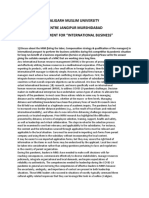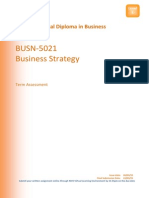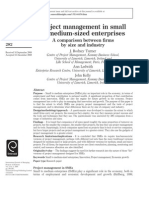Evaluation of Capital Budgeting Techniques Adopted by Small Scale Firms (A Case Study of Selected Firms, Aranla and Other Small Scale Firms)
Evaluation of Capital Budgeting Techniques Adopted by Small Scale Firms (A Case Study of Selected Firms, Aranla and Other Small Scale Firms)
Uploaded by
Morrison Omokiniovo Jessa SnrCopyright:
Available Formats
Evaluation of Capital Budgeting Techniques Adopted by Small Scale Firms (A Case Study of Selected Firms, Aranla and Other Small Scale Firms)
Evaluation of Capital Budgeting Techniques Adopted by Small Scale Firms (A Case Study of Selected Firms, Aranla and Other Small Scale Firms)
Uploaded by
Morrison Omokiniovo Jessa SnrOriginal Description:
Original Title
Copyright
Available Formats
Share this document
Did you find this document useful?
Is this content inappropriate?
Copyright:
Available Formats
Evaluation of Capital Budgeting Techniques Adopted by Small Scale Firms (A Case Study of Selected Firms, Aranla and Other Small Scale Firms)
Evaluation of Capital Budgeting Techniques Adopted by Small Scale Firms (A Case Study of Selected Firms, Aranla and Other Small Scale Firms)
Uploaded by
Morrison Omokiniovo Jessa SnrCopyright:
Available Formats
PROJECT CODE: 000042
EVALUATION OF CAPITAL BUDGETING TECHNIQUES
ADOPTED BY SMALL SCALE FIRMS (A CASE STUDY OF
SELECTED FIRMS, ARANLA AND OTHER SMALL SCALE
FIRMS)
PROJECT CODE: 000042
ABSTRACT
The primary aim of every business organization is to
make profits to ensure its continuous survival and stay in
business. Most firm resort to various survival strategies.
During the course of this study, personal interview were held
with senior officers of the firm selected in addition to
questionnaires. Those interviewed were either directly involved
in evaluating project proposals using conventional methods or
involved in using unconventional method. However, it was
found that two companies Predmount Plywood and Bijou (Nig)
Limited used both the payback and not present value while the
other use informal methods. It was discovered that with the
increasing complexity of this business environment. Owners of
Small Scale firms are either acquiring re-requisite qualification
consisting of degree and diploma of hiring capable qualified
hands. Furthermore, adequate attention to techniques of
capital budgeting. On the strength of the findings, it
recommended among others that there should be exchange of
idea between academician and practicing mangers where by
each will have the opportunities of stepping into the others
show to have a first hand knowledge of what obtains in their
respective five and that firms should assign at least one
specialist to fill time capital budgeting in order to maximize
gain from such practice.
PROJECT CODE: 000042
CHAPTER ONE
INTRODUCTION
Capital budgeting is seen as involving the entire
process of planning expenditure whose return are expected
beyond one year. Weston and Brighton (1995) refer capital
to fixed assets used in production, whereas dudget is a
plan which details project inflow and outflowduring some
future period.
Thus means capital budgeting outlines the planned
expenditures of fixed assets. Kac et al., (1991) defined
capital budgeting as a process that helps managers plan
for the acquisition and financing of long-term investment
primary fixed assets.
Duncan Williamson (1996) defined capital budgeting
as the acquisition or disposal of capital assets such as
land building plan; equipment and vehicles. The capital
PROJECT CODE: 000042
budgeting decision is one that involves the entire process
of whether to make a capital investment decision. These
definitions are at consent that capital budgeting involves
long term investment appraisal and control.
Organisations are set up to achieve specific objectives
or goals. Such objectives or goals ranges from earning
adequate return on investment to providing social services
to the community. Every organisation plan it activities in
order to employ available resources efficiently towards the
achieving of these set objectives.
Planning can be defined as deciding in advance action
to be taken in future, taken into consideration all the
necessary step resources required to bring them into
reality. Both large and medium and small scale firms see
their objectives through the planning process so as to
ensure optimum allocation of their resources.
PROJECT CODE: 000042
Small Scale firms are by their nature not practically
easy to define because, the expression covers a wide range
of activities which are related to social and economic
development stage of a country Management Science in
Delfe University, Netherlands (1993) define small scale
firms as one of which the manger personally performs all
the function of managing 10 19 persons. Aluko (1992)
defined the upper and limit of small scale firms as to suit
its own environment and purpose in the light of the level of
industrial
development.
The
small
scale
business
administration United State government agency aim at
protecting and promoting small scale firm given multiple
definition, guideline or provision for small scale firm are as
follows:
1) Independently owned and generated
2) Not domination in its field of operation
PROJECT CODE: 000042
3) Maximum number of employee shall vary from
industry to industry.
4) Maximum collar volume of business.
In Nigeria and many African and Asian countries,
crafts and cottage firms form or classified as small scale
industries. Given our stage of industrial development, the
following definition have been given or offered by different
institution over time. In central Bank of Nigerian (CBN)
credit guideline in commercial and merchant banks since
the late 90s, no small scale firm are defined as an
organisation with annual turnover.
Furthermore, small scale firms were defined by
NERFUND as those with fixed asset not more than 2
million when the naira was exchanged at 5 to $1, but
with continuous depreciation in naira, the above definition
has become unrealistic that small scale were regarded as
PROJECT CODE: 000042
those with fixed asset not more than 36 million. Aluko et
al., (1992) gave hepatitis of small scale firm to include:
1) The same manger/proprietor take charge of the
functional activities such as finance, production and
marketing.
2) The industry is closely integrated with and meets
only the immediate needs of the local community in
which he arises on the business.
3) The level of education of the proprietor is usually
very low with a consequent low level of business.
Management
techniques,
skill
or
marketing
information. He also fails to plan for management
succession like large and medium scale firm, the
investment
decision
of
small
scale
firm
are
commodity called budgeting or capital expenditure
decision.
PROJECT CODE: 000042
In addition, as reported by Soludo (1994) in line
study of manufacturing firms, small-scale firm have to be
cash oriented.
They are pre-occupied with how to survive, hence
they focus their attention on expenditures from the
standpoint of their nearer team effect on cash and survival
instant was, then to concentrate on the relatively short
time horizon and thus in turn lea to an emphasis on the
payback period. To this extent, small-scale industries have
selected to be used as a study in this research.
1.1 Statement of Research Problem
The future success and growth of a business depend
on the investment decisions made today. All investment
decision are usually approved by the chief executive or
board of directors. This fact is an open secrete among
business managers. Inspite of this fact, the procedure used
PROJECT CODE: 000042
to help management made (investment decision) or often
inadequate and misleading. Studies carried out suggest
that among small scale industries use back-of envelop
analysis or perhaps even no analysis at all. Brighan
(1998). For instance, in a study of small manufacturing
firm in Lowa, USA Soludo (1994) disc overed that more
than 50 percent of the companies rely fully on payback or
similar criteria and over 40 percent used no formal
analysis at all. The above result is puzzling and band
bewding. They often neglect the use of the conventional
decision on making techniques developed to improve
decision by small business even through most of their
manager appreciate the importance of capital budgeting
has been explained by various argument some of which
consist:
PROJECT CODE: 000042
- that manager of small firms are simply not well
trained
- that management talent is a scare resource in small
firms.
- That the cost of analysis capital projects are fixed
therefore, it may not be economical.
1.2 Objective of the Study
The role played by small-scale firms in developing
country like Nigeria can better be appreciated by looking at
their roles, there is need for their sustained growth and
stability.
The objective of this study therefore is to evaluate the
following.
- whether or not small-scale firm practice capital
budgeting techniques as theoretically postulated.
PROJECT CODE: 000042
- Whether
risk
and
uncertainty
factor
normal
associated with investment decision are taken into
consideration.
- Whether the Nigeria environment (economic and
business peculiarities vis--vis those of the selected
firm prevent from making use of such sophisticated
techniques.
- If the general perceived low level of education among
small scale business mangers is also responsible for
the neglected use of conventional decision making of
the selected firms.
1.3 Research question
1) Conventional capital budgeting technique are not
used in practice by small scale firm.
PROJECT CODE: 000042
2) Low level of education background and lack of
managerial expertise is responsible for their choice of
unsophisticated technique(s).
3) The Nigerian government (economic and business)
peculiarities hinder the selected firms from making
use of conventional method.
1.4 Significance of Study
This study is informed by the need to ascertain whether or
not
small-scale
firm
employ
sophisticated
capital
budgeting technique in appraising their project proposal.
The significant of the study is therefore under scored
by the following.
1. That knowledge of capital budgeting techniques is
very vital since decisions are critical to the success or
failure of any organisation.
PROJECT CODE: 000042
2. An
awareness
and
understanding
their
global
application of capital budgeting theory and practice
are hindered by environmental factors, will enable us
to bend such theory and practice to suit local
circumstances.
3. That explicit recognition and provision for risk in
capital budgeting decision by managers of small scale
business will likely reduce the incidence of project.
1.5 Scope and Limitation of Study
Information is scanty on the exact budgeting techniques
used by small firms in developing countries. However,
there is evidence that such firm in Nigeria generally make
use of unconventional methods. This study is therefore
undertaken to cover various tools develop over ages viz.
The payback period, the account rate return, their
application by small scale business firm including the
PROJECT CODE: 000042
process capital budgeting and its importance. This study
work is however greatly limited by the short-term period
within which it has to be completed as well as dislocation
of final year student.
PROJECT CODE: 000042
TO GET THE FULL PROJECT MATERIAL (CHAPTER 1
TO FIVE) FOLLOW THIS SIMPLE STEPS:
STEP 1:
visit any Ecobank branch nearest to you
and pay into the account details below:
ACCOUNT NAME: TEEZED BUSINESS ENTERPRISES
ACCOUNT NUMBER: 3583011916
ACCOUNT TYPE: CURRENT
AMOUNT: 3,000
STEP 2:
After payment, SMS the Teller Number,
the project code (can be found at the
header of this project work) and your
address
TO
08067950556,
08110684119.
Upon confirmation of the payment, the
full project will be sent to you (this will
usually take few minutes after payment
is confirmed).
STEP 3:
Go to your mail and download the full
project materials.
NB: To view other Banks, go to www.teezed.com.ng
DISCLAIMER:
We at Teezed strongly advice that the research you
will get from us should be used as a guide rather
than as a template for personal research. This
research work is intended to guide you and to
provide you with idea on how a typical research
work looks like
You might also like
- Project On Capital BudgetingDocument81 pagesProject On Capital Budgetingshyampatricks76% (108)
- Investment Consulting Business PlanDocument9 pagesInvestment Consulting Business Planbe_supercoolNo ratings yet
- Project Appraisal of HotelDocument81 pagesProject Appraisal of HotelJatin RamaniNo ratings yet
- Income and Changes in Retained Earnings: - Chapter 12Document49 pagesIncome and Changes in Retained Earnings: - Chapter 12Moqadus SeharNo ratings yet
- Aligarh Muslim University Centre Jangipur Murshidabad Assignment For "International Business"Document4 pagesAligarh Muslim University Centre Jangipur Murshidabad Assignment For "International Business"Barkha LohaniNo ratings yet
- CHAPTER-1 Introduction: 1.1 Overview 1.2 Meaning of Capital BudgetingDocument15 pagesCHAPTER-1 Introduction: 1.1 Overview 1.2 Meaning of Capital BudgetingPratibha NagvekarNo ratings yet
- IJRPR7350Document6 pagesIJRPR7350Munna Kumar YadavNo ratings yet
- Chapter One 1.0 1.1 Background To The StudyDocument56 pagesChapter One 1.0 1.1 Background To The Studyolusola ololadeNo ratings yet
- Assignment Subject: International BusinessDocument6 pagesAssignment Subject: International BusinessRizwan PazheriNo ratings yet
- Itc SrinivasaraoDocument76 pagesItc SrinivasaraoVenkatesh Periketi100% (3)
- Tybms, 563, Chinmay Joshi - If ProjectDocument11 pagesTybms, 563, Chinmay Joshi - If ProjectVivek sharmaNo ratings yet
- Term Paper of Financial ManagementDocument6 pagesTerm Paper of Financial Managementafmzmxkayjyoso100% (2)
- Explaining Growth and Consolidation in RP Microfinance InstitutionsDocument70 pagesExplaining Growth and Consolidation in RP Microfinance InstitutionsJovi DacanayNo ratings yet
- Capital Budgeting Decisions: Fadi Alkaraan and Trevor HopperDocument32 pagesCapital Budgeting Decisions: Fadi Alkaraan and Trevor Hopperh417d1k4No ratings yet
- Project Report On Capital Budgeting @kesoramDocument75 pagesProject Report On Capital Budgeting @kesoramRajesh BathulaNo ratings yet
- Title:-Capital Budgeting and Its Techniques in Prathi Solutions Private LimitedDocument76 pagesTitle:-Capital Budgeting and Its Techniques in Prathi Solutions Private LimitedabhishekNo ratings yet
- BUSN-5021 Business Strategy: Higher National Diploma in BusinessDocument5 pagesBUSN-5021 Business Strategy: Higher National Diploma in BusinessScott KramerNo ratings yet
- The Impact of Corporate Strategy On Investment Decisions ofDocument77 pagesThe Impact of Corporate Strategy On Investment Decisions ofRonke Joseph Folagbade100% (1)
- Introduction StramaDocument62 pagesIntroduction StramaEnnAoeihG PajarinNo ratings yet
- Saudi Electronic University College of Administrative and Financial Sciences E-Commerce DepartmentDocument9 pagesSaudi Electronic University College of Administrative and Financial Sciences E-Commerce Departmentklm klmNo ratings yet
- Thesis On Financial Management PracticesDocument6 pagesThesis On Financial Management Practicesgbvjc1wy100% (1)
- CorporatizationforMSMEs 0Document44 pagesCorporatizationforMSMEs 0pateldeaNo ratings yet
- Effective Management Strategies For Small BusinessDocument6 pagesEffective Management Strategies For Small BusinessmoncillerjeanerlynNo ratings yet
- ACF AssignmentDocument27 pagesACF AssignmentAmod GargNo ratings yet
- Contemporary Issues in Finance - International Aspects of Corporate Finance - Jerralyn AlvaDocument5 pagesContemporary Issues in Finance - International Aspects of Corporate Finance - Jerralyn AlvaJERRALYN ALVANo ratings yet
- Management of Small Scale Industries..Document9 pagesManagement of Small Scale Industries..Fancyfantastic KinuthiaNo ratings yet
- Critical Factors For The Successful ImplementationDocument10 pagesCritical Factors For The Successful Implementationlamamu068No ratings yet
- Improving Business Practices and The Boundary of The Entrepreneur A RandomiOutsourcingDocument86 pagesImproving Business Practices and The Boundary of The Entrepreneur A RandomiOutsourcingBahar MdNo ratings yet
- Project Chapter 1&2Document8 pagesProject Chapter 1&2Vishnu Priyan . SNo ratings yet
- Review of LiteratureDocument14 pagesReview of LiteratureMohanMahi100% (2)
- T Proc Notices Notices 090 K Notice Doc 86045 933083426Document6 pagesT Proc Notices Notices 090 K Notice Doc 86045 933083426Yemi FajingbesiNo ratings yet
- Assignments - Strategic ManagementDocument6 pagesAssignments - Strategic Managementcomputer.jaipur123No ratings yet
- SYIF RecommendationsDocument4 pagesSYIF RecommendationsSarah ThelwallNo ratings yet
- Total QuesDocument46 pagesTotal Queskhare_girishNo ratings yet
- Management StragegiesDocument11 pagesManagement StragegiesStephen Masafu SimiyuNo ratings yet
- Capital Budgeting Project ReportDocument97 pagesCapital Budgeting Project ReportPriyanshu Singh0% (1)
- 1 - Script Docx-1Document8 pages1 - Script Docx-12020200215No ratings yet
- Strategic Manager - AssignmentDocument7 pagesStrategic Manager - AssignmentVishal SinghNo ratings yet
- Writing A Knowledge Management Business CaseDocument12 pagesWriting A Knowledge Management Business CaseCarl RoosNo ratings yet
- Week 4 - Topic OverviewDocument11 pagesWeek 4 - Topic OverviewmichNo ratings yet
- Ba 1734 - Entrepreneurship Development Part ADocument8 pagesBa 1734 - Entrepreneurship Development Part Adhasarathan_cNo ratings yet
- Chapter 2Document18 pagesChapter 2Yosef KetemaNo ratings yet
- Book ReviewDocument14 pagesBook ReviewRena Jocelle NalzaroNo ratings yet
- Lession 0003Document15 pagesLession 0003Dr Suman RamapatiNo ratings yet
- Vinay Project Report......Document77 pagesVinay Project Report......shivuhitliNo ratings yet
- Nigerian Bussiness EnvironmentDocument15 pagesNigerian Bussiness EnvironmentKAYODE OLADIPUPO0% (1)
- The Study and Application of Financial Management Knowledge Is Highly Relevant To Dangote Group of Companies in NigeriaDocument6 pagesThe Study and Application of Financial Management Knowledge Is Highly Relevant To Dangote Group of Companies in NigeriaALI PAUL TOOCHUKWUNo ratings yet
- Business FinanceDocument25 pagesBusiness FinanceRhea LanuzaNo ratings yet
- Wa0003.Document27 pagesWa0003.Khader MohamedNo ratings yet
- 10 1016@j Omega 2005 04 001Document12 pages10 1016@j Omega 2005 04 001Michael MenberuNo ratings yet
- Dissertation On Portfolio ManagementDocument7 pagesDissertation On Portfolio ManagementCustomWrittenPapersSingapore100% (1)
- 03 - Working With Private Sector For Development - Experiences and Lessons From AIP-Rural PDFDocument16 pages03 - Working With Private Sector For Development - Experiences and Lessons From AIP-Rural PDFDaniel S. NugrahaNo ratings yet
- Financial Management in ConstructionDocument26 pagesFinancial Management in ConstructionSoufiane Ouaadidy100% (1)
- Capital BudgetingDocument35 pagesCapital Budgetinggkvimal nathan100% (3)
- Project Management in Small To Medium-Sized Enterprises: A Comparison Between Firms by Size and IndustryDocument15 pagesProject Management in Small To Medium-Sized Enterprises: A Comparison Between Firms by Size and IndustryالمهندسالمدنيNo ratings yet
- Constraints For Growth of Small and Medium Scale Entreprises FinalDocument80 pagesConstraints For Growth of Small and Medium Scale Entreprises FinalPrince Kennedy Mark OgucheNo ratings yet
- A Study On Capital BudgetingDocument12 pagesA Study On Capital Budgetingharisshaikh7070No ratings yet
- A Governance Framework for Climate Relevant Public Investment ManagementFrom EverandA Governance Framework for Climate Relevant Public Investment ManagementNo ratings yet
- Translating Strategy into Shareholder Value: A Company-Wide Approach to Value CreationFrom EverandTranslating Strategy into Shareholder Value: A Company-Wide Approach to Value CreationNo ratings yet
- EJMCM - Volume 8 - Issue 1 - Pages 1200-1212Document13 pagesEJMCM - Volume 8 - Issue 1 - Pages 1200-1212Morrison Omokiniovo Jessa Snr100% (1)
- Employee Participation in Decision-Making PDM andDocument8 pagesEmployee Participation in Decision-Making PDM andMorrison Omokiniovo Jessa SnrNo ratings yet
- Participation in Decision Making QuestionnaireDocument21 pagesParticipation in Decision Making QuestionnaireMorrison Omokiniovo Jessa SnrNo ratings yet
- Causes and Prevalence of Antisocial Behaviour Among Students With Hearing Impairment in Ibadan, NigeriaDocument6 pagesCauses and Prevalence of Antisocial Behaviour Among Students With Hearing Impairment in Ibadan, NigeriaMorrison Omokiniovo Jessa SnrNo ratings yet
- Drug Abuse, Drug Use, Anti-Social Behaviour, Achievement in Biology, Gender, Students and DrugDocument13 pagesDrug Abuse, Drug Use, Anti-Social Behaviour, Achievement in Biology, Gender, Students and DrugMorrison Omokiniovo Jessa SnrNo ratings yet
- Measuring Empowerment in Working Life: A Review: Work February 2006Document11 pagesMeasuring Empowerment in Working Life: A Review: Work February 2006Morrison Omokiniovo Jessa SnrNo ratings yet
- Domestic Abuse and Antisocial Behaviour Among Students in Aba Education ZoneDocument8 pagesDomestic Abuse and Antisocial Behaviour Among Students in Aba Education ZoneMorrison Omokiniovo Jessa SnrNo ratings yet
- Marital Adjustment of Working Class and Non-Working Class Women in Port Harcourt Metropolis, NigeriaDocument4 pagesMarital Adjustment of Working Class and Non-Working Class Women in Port Harcourt Metropolis, NigeriaMorrison Omokiniovo Jessa SnrNo ratings yet
- International Journal of Arts and Humanities (IJAH) Bahir Dar-EthiopiaDocument13 pagesInternational Journal of Arts and Humanities (IJAH) Bahir Dar-EthiopiaMorrison Omokiniovo Jessa SnrNo ratings yet
- Tests For Two CorrelationsDocument10 pagesTests For Two CorrelationsMorrison Omokiniovo Jessa SnrNo ratings yet
- Assessment Strategies and Remediation of Antisocial BehavioursDocument15 pagesAssessment Strategies and Remediation of Antisocial BehavioursMorrison Omokiniovo Jessa SnrNo ratings yet
- Construction of Economics Achievement Test For Assessment of StudentsDocument7 pagesConstruction of Economics Achievement Test For Assessment of StudentsMorrison Omokiniovo Jessa SnrNo ratings yet
- Ala ApaDocument4 pagesAla ApaMorrison Omokiniovo Jessa SnrNo ratings yet
- Contributions of Education For Sustainable Development (ESD) To Quality Education: A Synthesis of ResearchDocument17 pagesContributions of Education For Sustainable Development (ESD) To Quality Education: A Synthesis of ResearchMorrison Omokiniovo Jessa SnrNo ratings yet
- The Effect of Child Abuse On The Achievement of Students in Biology in Etsako West Local Government Area of Edo StateDocument18 pagesThe Effect of Child Abuse On The Achievement of Students in Biology in Etsako West Local Government Area of Edo StateMorrison Omokiniovo Jessa SnrNo ratings yet
- Challenges Facing Effective Implementation of Guidance and Counselling Programmes in Selected Institutes of Technology in Wasa Amefi Central District in The Western Region of GhanaDocument51 pagesChallenges Facing Effective Implementation of Guidance and Counselling Programmes in Selected Institutes of Technology in Wasa Amefi Central District in The Western Region of GhanaMorrison Omokiniovo Jessa SnrNo ratings yet
- Factors Which Influence The Buying Behaviours of Customers With Multiple Regular Customer CardsDocument74 pagesFactors Which Influence The Buying Behaviours of Customers With Multiple Regular Customer CardsMorrison Omokiniovo Jessa SnrNo ratings yet
- Body Image and Risk Behaviors in Youth With HIVDocument6 pagesBody Image and Risk Behaviors in Youth With HIVMorrison Omokiniovo Jessa SnrNo ratings yet
- The Role of Vigilante GroupsDocument18 pagesThe Role of Vigilante GroupsMorrison Omokiniovo Jessa SnrNo ratings yet
- Antibacterial Properties of Leaf Extracts Of: Moringa Oleifera Lam. Growing in SudanDocument5 pagesAntibacterial Properties of Leaf Extracts Of: Moringa Oleifera Lam. Growing in SudanMorrison Omokiniovo Jessa SnrNo ratings yet
- 5996 23253 1 PBDocument108 pages5996 23253 1 PBMorrison Omokiniovo Jessa SnrNo ratings yet
- WWW EconomicsdiscussionDocument12 pagesWWW EconomicsdiscussionMorrison Omokiniovo Jessa SnrNo ratings yet
- The Role of Vigilante GroupsDocument18 pagesThe Role of Vigilante GroupsMorrison Omokiniovo Jessa SnrNo ratings yet
- The Role of Vigilante GroupsDocument7 pagesThe Role of Vigilante GroupsMorrison Omokiniovo Jessa SnrNo ratings yet
- Effects of Moringa (Moringa Oleifera) Leave On Electrolyte in Rats Fed Crude Oil Contaminated DietDocument10 pagesEffects of Moringa (Moringa Oleifera) Leave On Electrolyte in Rats Fed Crude Oil Contaminated DietMorrison Omokiniovo Jessa SnrNo ratings yet
- Impact of School Location On Academic Ac PDFDocument4 pagesImpact of School Location On Academic Ac PDFMorrison Omokiniovo Jessa SnrNo ratings yet
- Effect of Bitter Leave Aqueous Extract On Serum and Liver, Aspartate Aminotransferase (Ast), Alanine Aminotransferase (Alt) and Total Protein Levels in Alloxen - Induced Diabetic RatsDocument7 pagesEffect of Bitter Leave Aqueous Extract On Serum and Liver, Aspartate Aminotransferase (Ast), Alanine Aminotransferase (Alt) and Total Protein Levels in Alloxen - Induced Diabetic RatsMorrison Omokiniovo Jessa SnrNo ratings yet
- Marketing L HDFC Life InsuranceDocument65 pagesMarketing L HDFC Life InsuranceSamuel Davis100% (1)
- P14 SFM (2nd Paper)Document9 pagesP14 SFM (2nd Paper)Shivam GuptaNo ratings yet
- EthnicDocument7 pagesEthnic李怡聪No ratings yet
- NDTC College of Business & Technical Vocational Courses Notre Dame of Tacurong CollegeDocument21 pagesNDTC College of Business & Technical Vocational Courses Notre Dame of Tacurong CollegeAlvin Jay BernardinoNo ratings yet
- Banking Sector Module - Sample PaperDocument5 pagesBanking Sector Module - Sample PaperBilavathRajeshNo ratings yet
- Income StatementDocument7 pagesIncome StatementZahidRiazHaansNo ratings yet
- Sources of Finance For Startups and SMEsDocument4 pagesSources of Finance For Startups and SMEsTawanda Percy MutsandoNo ratings yet
- Effect of Audit Quality On The Financial Performance of Selected Banks in NigeriaDocument14 pagesEffect of Audit Quality On The Financial Performance of Selected Banks in NigeriaEditor IJTSRDNo ratings yet
- Acquisition Finance Funding Sources For AcquisitionsDocument17 pagesAcquisition Finance Funding Sources For Acquisitionsparidhi.guptaNo ratings yet
- FINANCIAL MANAGEMENT MODULE 1 6 1st MeetingDocument69 pagesFINANCIAL MANAGEMENT MODULE 1 6 1st MeetingMarriel Fate CullanoNo ratings yet
- CH-8 SMDocument47 pagesCH-8 SMShalle said AdenNo ratings yet
- Final ProjectDocument18 pagesFinal ProjectZaid AnsariNo ratings yet
- Nism Xvi - Commodity Derivatives Exam - Practice Test 6Document53 pagesNism Xvi - Commodity Derivatives Exam - Practice Test 6Sohel KhanNo ratings yet
- Functions of The Central BankDocument6 pagesFunctions of The Central BankVenkat SaiNo ratings yet
- The Bible of Trend Following - Table of ContentsDocument18 pagesThe Bible of Trend Following - Table of Contentsandy abraham41% (29)
- Ac3b Qe Oct2014 (TQ)Document12 pagesAc3b Qe Oct2014 (TQ)Julrick Cubio EgbusNo ratings yet
- Mini MBA B10 - 01 Financial Management - Day 01Document41 pagesMini MBA B10 - 01 Financial Management - Day 01Reza MonoarfaNo ratings yet
- New NZD StrategyDocument11 pagesNew NZD StrategyNguvulu MakayiNo ratings yet
- NCBA-Quiz LAWDocument2 pagesNCBA-Quiz LAWRONZALES, Genie RoseNo ratings yet
- Ann 11.4 - Dematerialisation Request FormDocument2 pagesAnn 11.4 - Dematerialisation Request FormSwapnilsagar VithalaniNo ratings yet
- Capital AllocationDocument75 pagesCapital Allocationak87840% (1)
- Business Finance ABM StrandDocument107 pagesBusiness Finance ABM StrandMiss Anonymous23No ratings yet
- Professional Practice Computation ExplanationDocument4 pagesProfessional Practice Computation ExplanationNathaniel RasosNo ratings yet
- Buyback: What Is A Buyback?Document3 pagesBuyback: What Is A Buyback?Niño Rey LopezNo ratings yet
- Aditya Mishra SOLDocument30 pagesAditya Mishra SOLMohitNo ratings yet
- FMCHAPTER ONE - PPT Power PT Slides - PPT 2Document55 pagesFMCHAPTER ONE - PPT Power PT Slides - PPT 2Alayou TeferaNo ratings yet
- ValueResearchFundcard ICICIPrudentialPharmaHealthcareAndDiagnostics (P.H.D) Fund 2019apr02Document4 pagesValueResearchFundcard ICICIPrudentialPharmaHealthcareAndDiagnostics (P.H.D) Fund 2019apr02SPNo ratings yet
- Chap 015Document21 pagesChap 015Zaid Osama AldwekNo ratings yet
- Case Study XDocument12 pagesCase Study XMd. Tanvir HasanNo ratings yet



















































































































